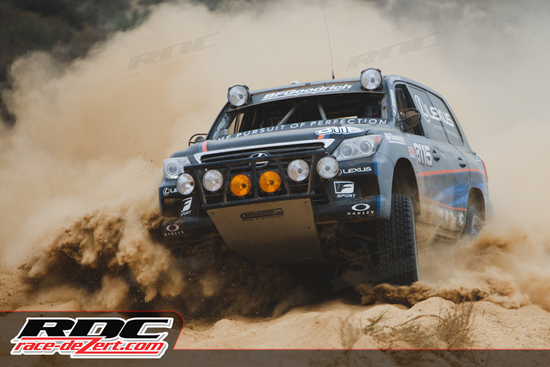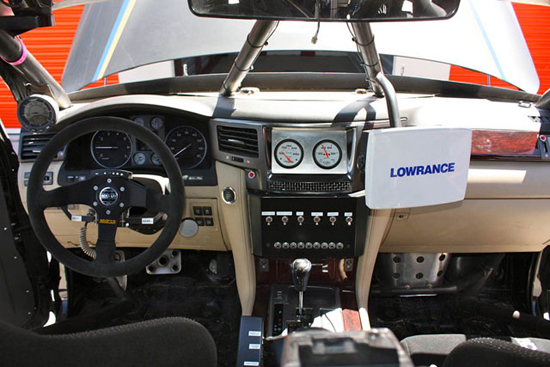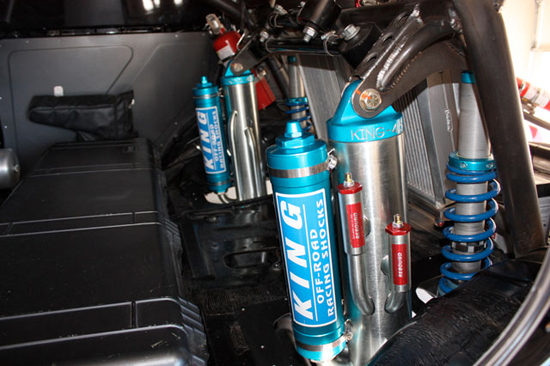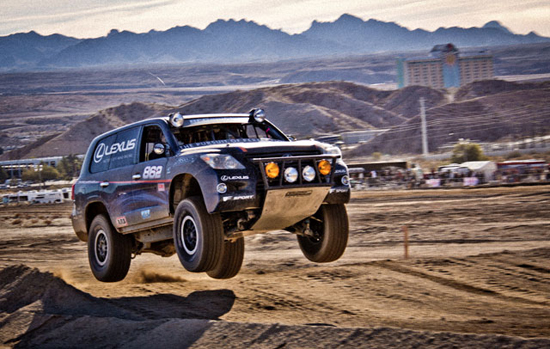Former Toyota Test Driver Wins Second Baja 1000 with Lexus LX 570
Tim Esterdahl | Mar 23, 2014 | Comments 22
UPDATE: Lexus will no longer be sponsoring Joe Bacal and his team. Bacal says that they have had a great run and he is looking forward to the future. We will keep you updated.
We got an email last week about a friend of ours, who happens to be a Toyota test driver (helped work on Tundra pickups), that he had won his second Baja 1000. Here’s the story.

Whether you are a fan of Baja or not, this is a great photo.
Professional driver and cancer survivor Joe Bacal spent quite a bit of time answering our questions in Jackson Hole, WY. He spent a lot of time working on Toyota vehicles on the track working on suspension and handling. He runs a performance driving school called JT Grey Performance Driving.
Joe races a seriously modified Lexus LX 570. The Baja 1000 is a punishing 1,122-mile race that covers a broad stretch of desert along Mexico’s Baja California Peninsula. In 2012, Bacal drove the entire course with the help of three different co-drivers. His winning time was 38 hours and 22 minutes with no rest stops. Incredibly, the LX 570 didn’t suffer from any mechanical issues, not even a flat tire — impressive when you consider the course route is notorious for booby traps and vandals.
His wife sent us the story on how he won the Baja event.
Joe won his second consecutive Baja 1000 when he crossed the finish line at the Tecate SCORE 2013 Baja 1000. This is his 3rd overall Baja 1000 win in the last 5 years. Team Lexus finished the race in 29 hours and 21 minutes. The only other Stock-Full Class truck to finish was Rod Hall who came across the finish line 4.5 hours after the Lexus.
This Lexus can really get some air time!
Joe had a few challenges in the beginning as the GPS locked up so they ran the first 65 miles without it. Then their radio wasn’t working. They couldn’t hear the chase crew but the chase crew could hear them. Fortunately, the GPS suddenly started working on its own and the chase crew changed out the radio antenna at BFG Pit 1, which solved the radio problem.
The rest of the race was problem free and was a combination of rock crawling, maneuvering extremely narrow goat trails and getting swallowed up in 4’ to 5’ deep silt beds. Joe said it was the toughest, most challenging Baja 1000 he has competed in these last 5 years.
Only 46% of the 251 competitors actually finished the race. Team Lexus placed 43rd overall which puts them in the top 40%. Joe Bacal is once again the points leader for the Stock-Full Class in 2013 SCORE International season.
We had a chance to interview Joe on his truck. Here is what he had to say.

The custom interior of the Lexus.
Q: Often times, race vehicles strip out the entire interior to save weight and facilitate adding a roll cage — how much have you removed from the LX racer?
A: The LX was stripped completely inside. The roll cage was built and ties in from the back to the front, and includes the suspension mounts. The interior wood dash and leather was re-installed to make it as clean and stock as possible. I use SPARCO seats, and this is the first LX to have paddle shifters.
Q: What fuel is the engine running?
A: The same 92 Octane recommended for the standard Lexus LX.
Q: Has the engine been tuned or touched by TRD?
A: The engine’s completely stock except for a custom air intake that relocates a larger air filter into the passenger side floor for dust protection. We also had TRD engineers remove 65 lbs. of wiring and sensors that were not needed. The original ECM computer was still used however to stay in the class rules.
Q: What add-ons or enhancements have been made?
A: Here’s the full list:
- TRD 17″ Rock Warrior Wheels
- TRD Brake pads
- 110 Watt Kenwood Race Radio
- 8 KC Hi Lights 70 Watt Carbon Fiber HIDs
- Dual Transmission coolers
- SPARCO EVO2 seats
- SPARCO steering wheel (custom paddle)
- Pelican case for parts
- Mastercraft 5 point seat belts/Suspension limit straps
- Lowrance 7HD GPS
- 46 Gallon custom FuelSafe fuel cell
- Dual Magnaflow short exhaust system (no cats)
Q: What can you tell me about the suspension setup and settings? What challenges have you had in terms of tuning the system?
A: We utilize all stock suspension parts for instance upper and lower A-arms, bushing and the solid axle 5 link in the rear. All bushings are stock. The only change in suspension are the actual shocks.

The King Shocks used on the Lexus.
We are sponsored by King Racing Shocks, and the front runs two King Shocks per wheel. I have mounted a 3.5” coilover that passes through the upper mount (cut out) into a higher custom shock mount location that ties into the roll cage. the secondary shock is strictly a 3.5″ triple bypass. At the full droop and full bump, I get almost 15” of usable travel. This is possible with the stock arms, 4WD half shafts, and stock steering components.
As for the rear suspension, I punched through the bed floor, and from eye to eye, the top and bottom shock bolt mount is 47” in length at full droop, with the King Kong 4.5” triple bypass. The rear coils have been removed, and a 2.5” air shock coilover holds up the LX in the rear. The rear suspension also has close to 15” of travel, but does not utilize air bump shocks front or rear due to the stock full class rules.
When it comes to the tuning, I work closely with Geiser Bros Design and Development out of Phoenix, along with the tuning guys at King Shocks. We really did our homework, and Geiser Bros did their magic on the entire build. We did a lot of static suspension tests with the 37” BFGoodrich KRT race project tries and even added a 2.5” body lift to get more up travel.
The process of tuning the vehicle is pretty complex, since I do a lot of the work on pavement. I try and dial in the front and rear balance first, so the vehicle is predictable on yaw response and is linear. This is key once you drop it in the desert. The compression settings are a bit soft, so I can utilize all of the suspension stroke but crank in some rebound to keep it flat. This LX570 is amazing at speed hitting the bumps.
Q: Has fuel economy been a problem or an issue you have had to work around?
A: Not really. I get about 5 to 7 MPG and just have to pit every 100 to 150 mile stops for fuel.
Q: Have you had any electrical issues with it?
A: We did when the vehicle was first built. LX went into “Limp Mode” for 3 races, which cost us the Championship last year.
Q: How does your race vehicle compare to other vehicles in the series? Are you faster, better able to handle curves or technical sections? What the relative strengths and weaknesses of this truck?
A: We are a serious competitor. I think the Ford teams are all hard to beat, so every race anyone can win. One major strength for the LX 570 is the fulltime 4WD system, the center diff lock, and the rear air locker. I also think the suspension is a key advantage running the double wishbone front and 5 link rear for high speed rally type roads.
Q: What have you learned about Lexus and their development process as a result of this project? Are Lexus engineers out in the field taking readings and testing things?
A: I think I am a little bias on this question. After being involved on many projects over the years and working and seeing the plants in Japan, Toyota has impressed me with the detailed precision that goes into each vehicle.
Lexus normally does not have staff join the races and do testing. My team handles the prep and testing, but I do have many Lexus members help on chase and logistics support. These guys are essential, not only as co-drivers, but with how they know this vehicle inside and out. I have many friends from my Toyota days who have been with me from the beginning.
What do you think? Pretty impressive to us!
Related Posts:
Search terms people used to find this page:
- tundraheadquarters
Filed Under: TundraHeadquarters.com



Impressive and riding in style too! I wonder if he got some funny looks racing in a luxury vehicle.
So, the LX570 runs on 92 octane for an extra 2 hp and 2 trq? Is the engine control computer any different from the Tundra’s?
LJC,
I forwarded your question on and we should get a response.
-Tim
LJC,
The man himself answered your question. Check out the comments.
-Tim
I just returned from a vacation in Arizona. I had an opportunity to go off road in the Land Cruiser version of this vehicle. Wow! A very capable off road platform even in relatively stock form. Ours had upgraded tire, suspension and lockers.
We traversed a mountain via road, trail and and riverbed encountering only two other vehicles. A Polaris ranger ATV, and another guy driving a Tacoma.
I never would have dreamed that an SUV could be such a competitor.
That Land Cruiser is really something. There is a reason why Toyota continues to support it with such low volume, consumers love it.
Tim-
I really appreciate the kind words and running this story! I hope people enjoy reading about my race LX570 and our success in the desert! I did want to clarify a few items about my involvement with the new Tundra. I was a test development driver from 1997-2007 and off road specialist for Toyota NA. I did work on the 2007-12? Toyota Tundra but did not have any involvement on the new changes for 2014 that was just released. My company JTGrey Performance Driving offers many things from ride and drive programs, vehicle testing, commercial – film, training and other services.
I currently race for Lexus USA and also contracted out for various jobs for the company.
To answer the fuel question above, I simply run super unleaded fuel in the LX race vehicle. This is the recommended octane for the 5.7 liter motor.
Again, thank you very much for getting us out there…..
Joe,
Thanks! Good luck in the future and keep us in the loop about what is going on with you and your company.
-Tim
Thank you Joe.
Well, this is interesting. Premium fuel is recommended for the LX570 (383 HP/403 TRQ) where regular fuel is for the Tundra (381 HP/401 TRQ). I wonder if the LX570 engine tuned for Premium fuel?
I always thought the engine and ECM were one in the same for both vehicles.
Good question on the fuel. My understanding is the LX requires the premium fuel and more than likely is tuned for this. I run premium regardless just for the best power and the harshness of racing.
Nice article. Thanks a lot.
I have seen supercharged LX570-s on youtube (the engine is the same as on the Tundra). Why was it not used in the build? Is it not allowed by the rules or is there any other reason?
correct on the supercharger….
Not legal in the stock full class
Thanks
Also it seems like the vehicle does not have a windshield. Is it intentional?
Yury,
It has a windshield. Just the way the photo is taken,
-Tim
Yes, almost every race vehicle in the SCORE series runs without a windshield. One main reason is rocks especially if a Trophy Truck passes with 850hp and a roost that will destroy it in seconds.
It does have a disadvantage on the lake beds at over 100mph.
LJC,
My wife has a Lexus GS350 with the 3.5L V6. It takes premium fuel also. It is rated at just over 300HP compared to 270HP for the Toyota version.
A couple reasons are direct injection, and higher compression pistons. I don’t know if the LX570 has a different compression ratio vs. the Tundra, I haven’t looked into it, but I’m guessing something along that line.
Thanks Speester. It looks like premium vehicles require or are recommended to run on premium fuel. The engine output for the LX570 and Tundra do not vary by much–I’d be curious to see the hp and dyno chart though. So, I wonder if simply running the Tundra on premium will result in the same gains. If so I wonder how LX570 owners would feel that the engine in their vehicle is no different from the one used in “common folks ride”.
@Joe Bacal: Why did you stick with the LX570 when it went into Limp Mode three times, which cost you the championship?
What is the brand of air locker that you use? I only one available that I know of is ARB. Just so you know, I kinda wish–and that’s putting it lightly–that the Tundra had an optional eLocker, especially since it’s current technology.
Does the LX570 you raced have the same rear axles, differential and transmission as the Tundra?
Crickets…
LJC,
I’ll follow up again. I know he did that interview and was traveling.
To answer your question on the “Limp Mode” this is all part of building a new vehicle. The TRD engineer who made my wire harness said this has most likely never been done and we removed 65 pounds of wires and sensors. We used the factory ECU but it just had issues during our first 3 races. We finally figured it out and it runs great now.
Many race cars encounter this when building using the factory harness and not a MOTEC.
I run the ARB air locker and it is the best!
The auto LSD on the Tundra works pretty good but yes I like the elockers.
No the LX does have some different parts – like the full time 4WD the Tundra does not offer.
@Joe: Thank you very much for answering questions! Sounds like the LX570 get’s a different tune. But if so, I would think a little more ga-ga would be on tap with premium dino-juice.
The reasons for my other questions about parts is this: just how much stock Tundra was in the LX570 when it was raced? I’m sure others may be interested as well.
Thanks again!
LJC,
I have been meaning to reply to this, sorry it has been crazy around here. I’m not sure Joe knows the answer to this question since he is driver not an engineer.
I can ask my Lexus source, but I believe that might be a tough question for them to answer. Why? They look at Toyota parts not parts only for this car or another.
My two cents.
-Tim